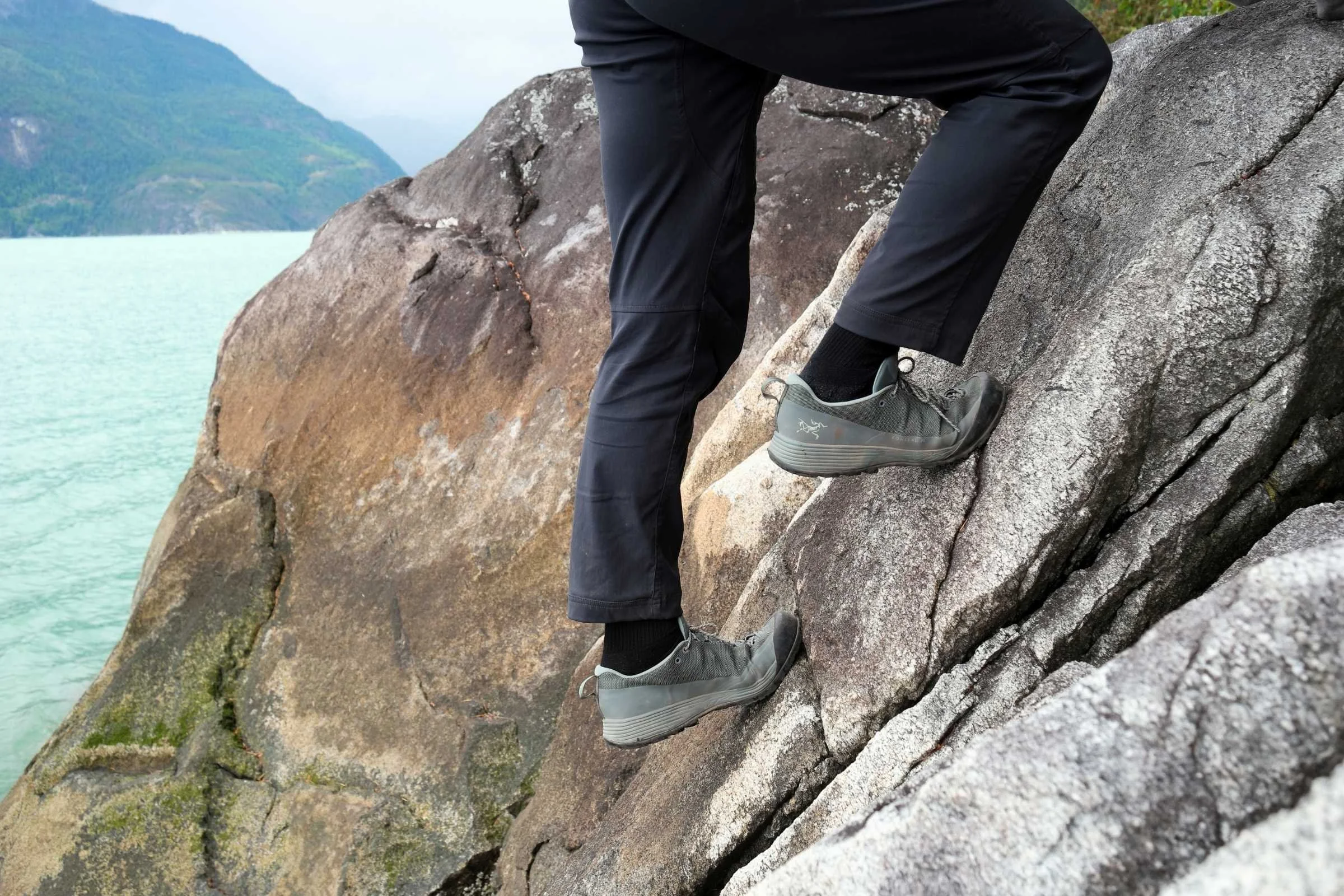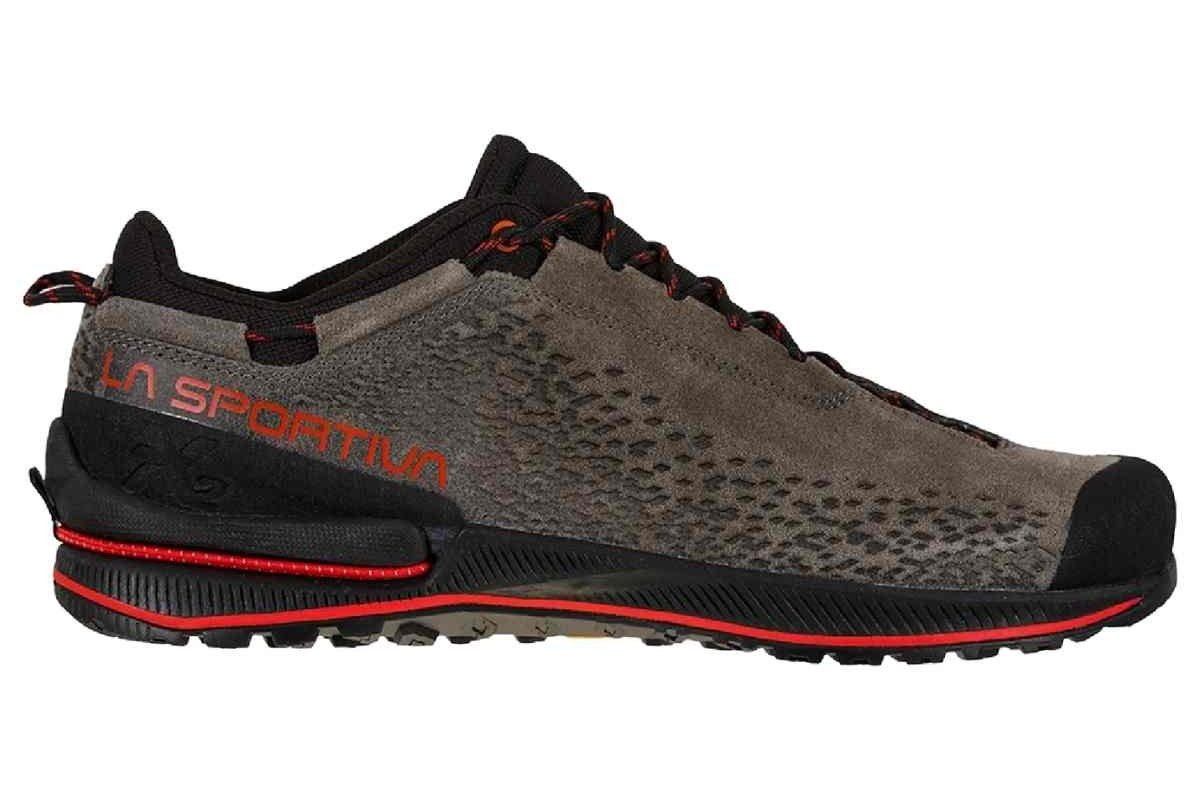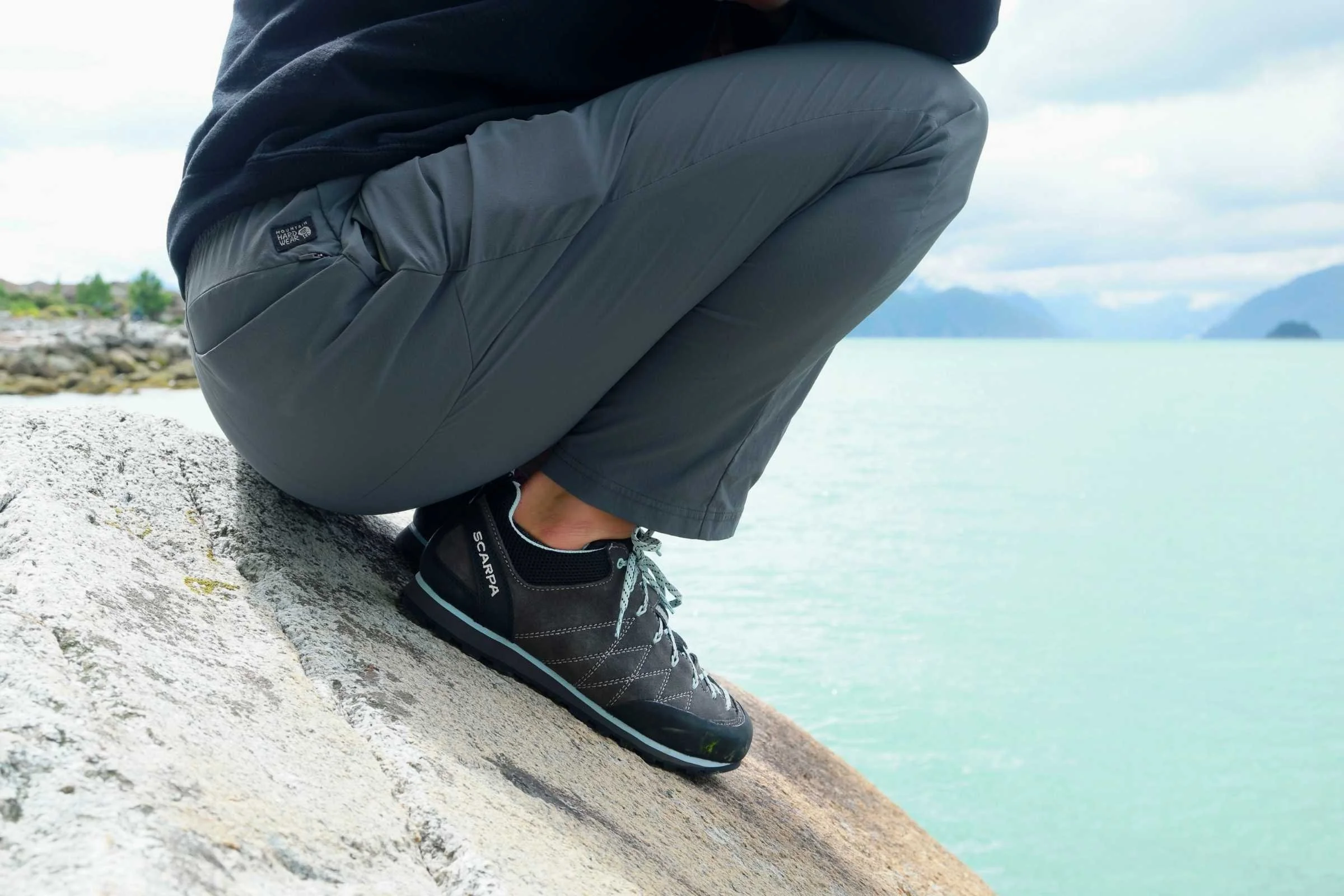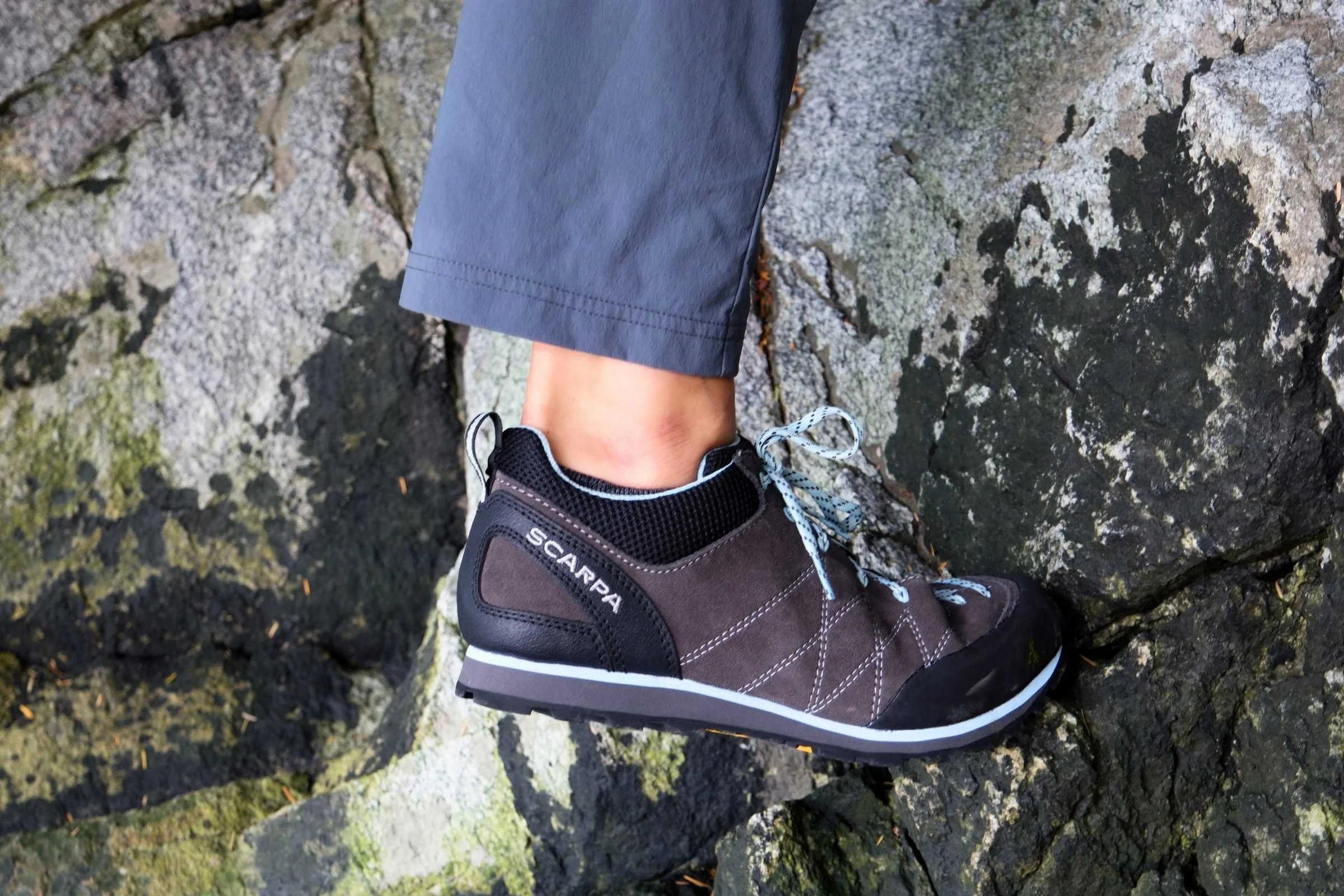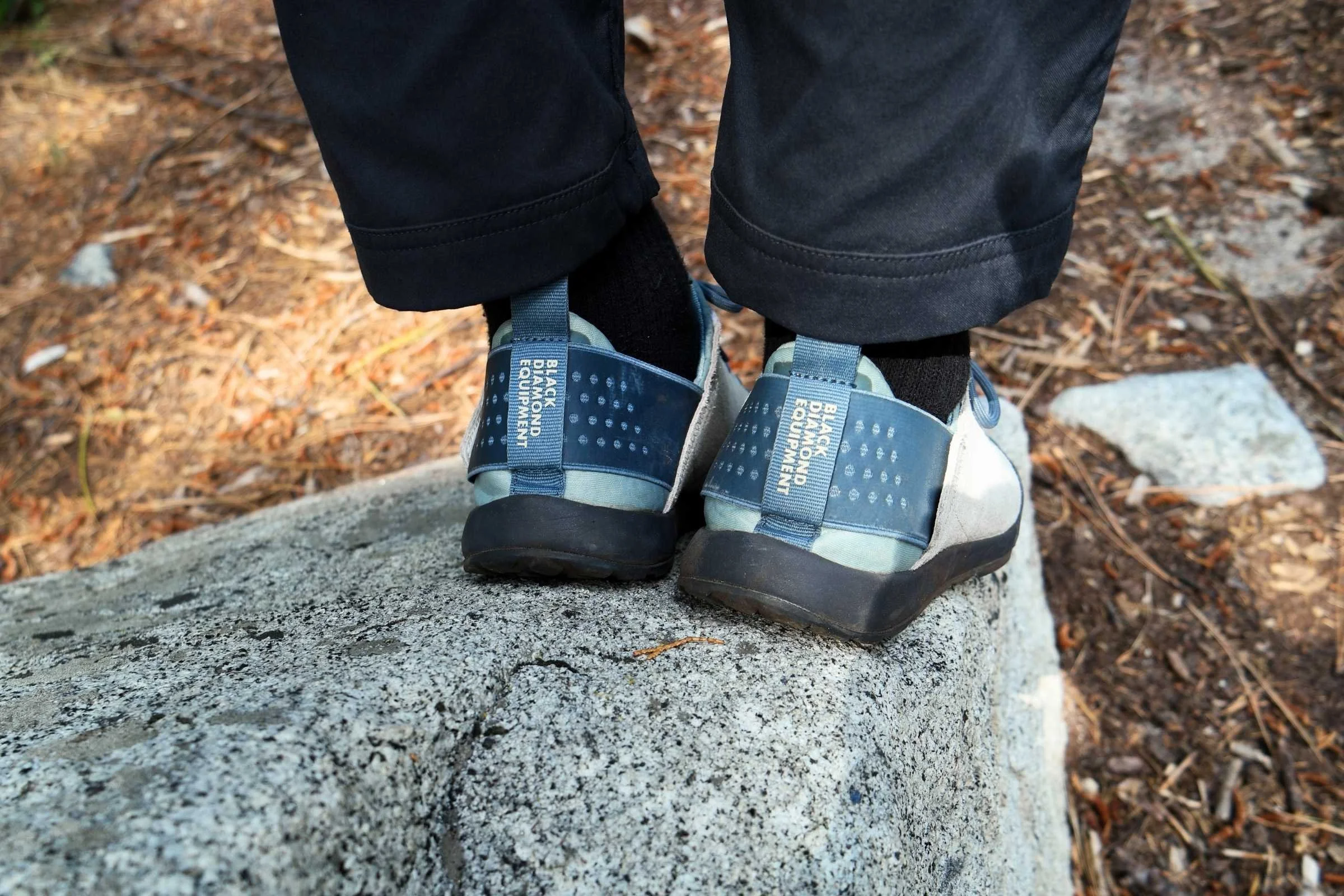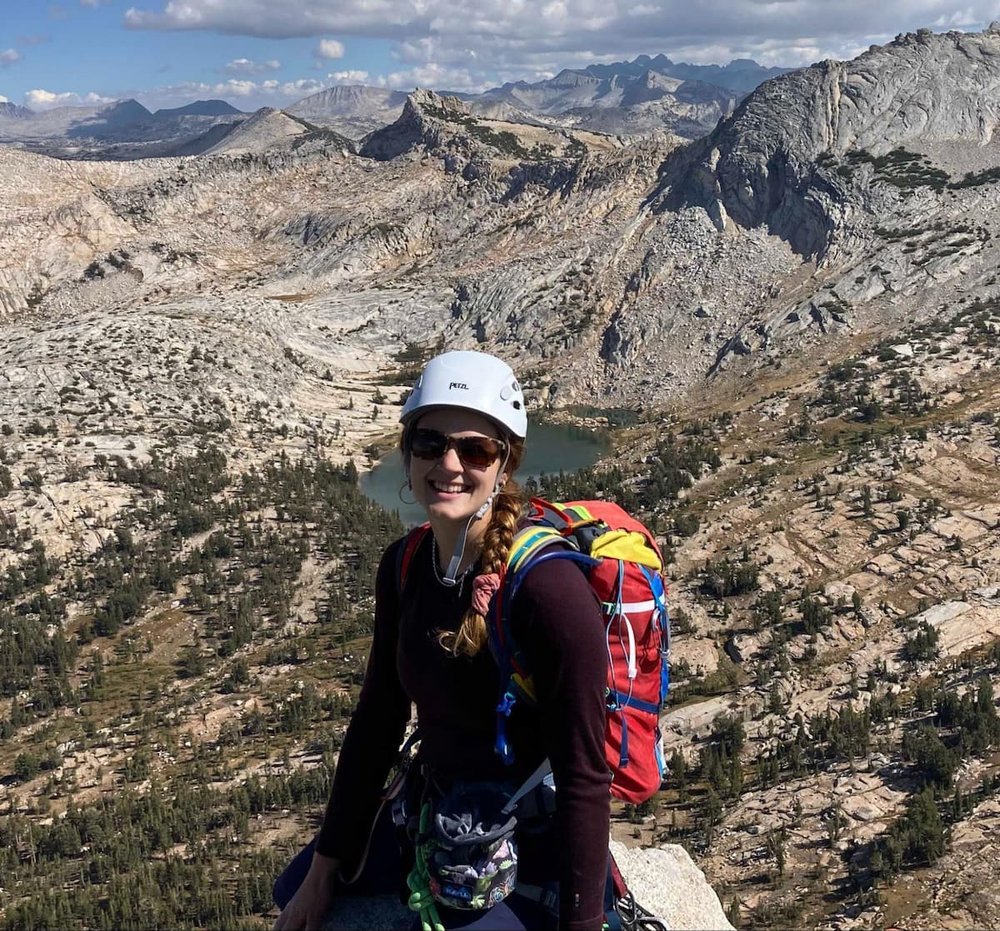Best Approach Shoes of 2025
Part climbing shoe, part hiking shoe with grip & sticky rubber for scrambling to your climb
September 25th, 2025, updated with a new waterproof winner, more testing notes from another summer's worth of climbing in new locations
Home > Gear Reviews > Footwear
Approach shoes are a hybrid between hiking shoes and climbing footwear—they offer the grip of a climbing shoe and the comfort of a hiker, so you can move confidently over rocky, exposed terrain en route to the crag. Whether you're scrambling up talus or downclimbing from a multi-pitch route, these shoes are grippy and comfortable for tricky approaches.
We tested a range of approach shoes in real climbing settings—from Yosemite and the High Sierra to Squamish, BC—evaluating how each performed during multipitch transitions, technical scrambles, long slab ascents and descents, and casual moves across forest trails, high alpine terrain, loose rock, and boulder fields.
Our evaluation criteria focused on traction (how sticky the soles gripped rock), sensitivity (how well you could feel the terrain), weight and packability, hiking comfort and support, durability in rugged terrain, and practical waterproofing features for multipurpose use.
Top Pick: The men's and women's La Sportiva TX2 EVO Leather Approach Shoes earn our overall winner distinction. They deliver excellent traction and rock feel, offer a supportive and packable design, and even feature a clever hidden rubber band to secure them together—plus the option to resole makes them a long-lasting staple for climbers.
We create reader-supported, objective, independently-selected gear reviews. This story may contain affiliate links, which help fund our website. When you click on the links to purchase gear, we may get a commission, without costing you an extra cent. Thank you for supporting our work and mission of outdoor coverage for every body! Learn more.
Comparison table
Men's
| HIKING SHOE | TREELINE AWARD | BEST FOR | WEIGHT (PAID) | UPPER | SOLE | MSRP |
|---|---|---|---|---|---|---|
| La Sportiva TX2 EVO Leather Approach Shoes | Best overall Read review |
All-around | 1 lb 2.3 oz | Nubuck leather, polyurethane TechLite toe and heel | Vibram Idrogrip Rubber | 159 |
| Arc'teryx Konseal | Best waterproof Read review |
Wet trail, long hikes in, exposed rock, vegan | 1 lb 12.9 oz | Nubuck leather | Vibram XS Flash 2 rubber | 190 |
| Black Diamond Technician Pro Approach Shoes | Best lightweight Read review |
Edging, durability, all-around | 1 lb 14.2 oz | Suede leather | Vibram Mega Grip | 200 |
| La Sportiva TX4 Approach Shoes | Best for wide feet Read review |
Long hikes, varied or rocky terrain | 1 lb 10 oz | Nubuck leather, TechLite/Vibram rubber toe rand | Vibram Megagrip | 189 |
Women's
| APPROACH SHOE | TREELINE AWARD | BEST FOR | WEIGHT (PAID) | UPPER | SOLE | MSRP* |
|---|---|---|---|---|---|---|
| La Sportiva TX2 EVO Leather Approach Shoes | Best overall Read review |
All-around | 1 lb 2.3 oz | Nubuck leather, polyurethane TechLite toe and heel | Vibram Idrogrip Rubber | 159 |
| Arc'teryx Konseal | Best waterproof Read review |
Wet trail, long hikes in, exposed rock | 1 lb. 8.3 oz | Nubuck leather | Vibram XS Flash 2 rubber | 190 |
| Black Diamond Technician Pro Leather Shoes | Best lightweight Read review |
Edging, durability, all-around | 1 lb 9.5 oz | Suede leather | Vibram Mega Grip | 200 |
| La Sportiva TX4 Approach Shoes | Best for wide feet Read review |
Long hikes, varied or rocky terrain | 1 lb 4.8 oz | Nubuck leather, TechLite/Vibram rubber toe rand | 189 | |
| Scarpa Crux II Approach Shoes | Long hikes | 1 lb 6.8 oz | Suede/polyester mesh | Vibram Vertical Approach Megagrip | 159 |
* Prices reflect MSRP at time of publishing and are subject to change. See our Deals Page for discounts and sales on products that win our awards.
Are you a climber? Check out our other Climbing guides:
The Winners
Best Overall Approach Shoe: La Sportiva Tx2 Evo Leather Approach Shoes
Weight: 1 lb 2.3 oz (pair)
Upper material: nubuck leather, polyurethane TechLite toe and heel
Sole rubber: Vibram Idrogrip Rubber
What we like: Great traction and sensitivity, molds to foot over time, bands to make compact for travel, can be resoled
What could be better: lightly too short laces, not waterproof
The TX2 EVOs are the best all-around approach shoes we tried. These shoes offer excellent traction and sensitivity while preserving comfort and support. For any short to intermediate distance the support is perfectly adequate. Where the TX2s really shine is on the rock. Climbing up and down, these gave the closest “climbing shoe” control on technical scrambling up talus fields and down crack systems. Add in packability for a multipitch, a wide toe box, and the option to resole when rubber wears thin, and you have an amazing all-around approach shoe!
view the La Sportiva TX2 Evo Leather Approach Shoes
Men's
Women's




No other shoe we tried has an almost hidden rubber band that can be used to secure the shoes together to make them more compact. While carrying an extra pair of shoes in a backpack up the wall, I found that bulkiness was more of a hindrance than weight. The rubber band on the TX2 EVOs helps reign in that bulkiness. Good thing these are a decently lightweight pair, too!
The leather upper and lacing system give a customizable fit that molds to your foot with use, kind of like a leather climbing shoe would. It is made of an EVO Leather, which has an eco nubuck leather made with ecological tanning processes. The TX2 is also available in a non-leather version (men's and women's) for those who prefer a vegan shoe.
Waterproofing may not be a priority for everyone since climbing requires dry and relatively warmer conditions, but if it is, keep in mind the TX2 EVOs do not offer any water resistance. The only other issue I can spot with these approach shoes is slightly short laces, but that was more of a minor inconvenience than an actual problem with performance. If it bothers you, consider replacing the laces.
Overall, the TX2 EVO shoes offer the exact technical features that make rocky terrain adventurers opt for approach shoes over a standard hiking shoe. Since the TX2 EVO shoes can also be resoled, they can last a long time in tip top shape.
These are the shoes I find myself continuously reaching for when I pack for a climbing weekend, and my first recommendation for anyone looking for a more technical version of a lightweight hiking shoe.
Best Waterproof Approach Shoe: Arc'teryx Konseal
Weight: 1 lb 6 oz (men’s), 1 lb 4 oz (women’s)
Upper material: Synthetic mesh, molded rubber toe cap
Sole rubber: Vibram MegaGrip rubber
What we like: Waterproof, excellent support, super lightweight and packable
What could be better: Not the most sensitive toe area, traction is not as good on loose soil/exposed roots/wooden surfaces (fallen trees)
The Arcteryx Konseal shoes are the best waterproof approach shoe we tested. Although the brand calls it "water resistant" and not waterproof, we were impressed by the durable water repellent coating on the Konseal that stays even after a lot of use.
Even without the bonus of waterproofing, which can be somewhat rare in approach shoes, the Konseals have amazing lateral support with a carbon fiber shank. Support side-to-side is an amazing feature for uneven terrain, especially for anyone recovering from ankle injuries or just looking for some preventative care.
The support in the Arcteryx Konseal approach shoes also makes it a super comfy option for lots of standing on uneven ground, like when you might be belaying! Somehow the great support on the Arcteryx Konseal does not sacrifice packability.
Although these are one of the heavier approach shoes we tested, these shoes are surprisingly light for what you get in this shoe. Every tester who has tried them comments on how lightweight they feel. The low profile makes them reasonably compact for carrying in or on a pack. Plus, they're made in a Fair Trade Certified factory.
Compare Prices Of the Arc'teryx Konseal
Men's
Women's


The Konseal uses a Vibram XS Flash 2 rubber that is grippier than the Vibram Megagrip in the previous model of Arc'teryx approach shoes we tested. While we had issues on loose dirt and log crossings in the last model, the newest model has fixed that issue. The toebox and ball of the foot on the newest model have a "climbing zone" designed for smearing. The heels have lugs designed for hiking downhill.
While we didn't test the Konseal while it was actively raining, the climate in Squamish B.C. is considered a very wet location with significant rainfall and is one of Canada's wettest inhabited areas. The Konseal waterproof approach shoe was useful for muddy trails and not-quite-dry slab. OThe waterproofing is useful on long approaches through rapidly melting snow.
As is a pattern with approach shoes offering more support, the Konseals are not the most precise or sensitive shoe we tested. Still, the lightweight carbon fiber shank in the midsole adds stability and stiffness that you'd expect from a much heavier shoe. As a result, these approach shoes are a lot lighter weight than they look.
I would recommend these shoes to anyone looking for a waterproof, supportive shoe that performs well both on long approaches, extended sections of low angle slab, and on exposed rock. However, these are not our recommended shoe for those looking to do super technical approaches or downclimbs that need lots of sensitivity and precision.
Best Lightweight Approach Shoe: Black Diamond Technician Leather Pro Approach Shoes
Weight: 1 lb 14.2 oz (men’s) 1 lb 9.5 oz (women’s)
Outsole: Vibram Mega Grip
Upper material: suede leather
Sole rubber: BlackLabel-Mountain rubber
What we like: Best support, wide toe box with comfortable lace up style, lightweight and don’t feel “clunky”
What could be better: Too rigid for much compact packing or hypersensitivity, one side secured “wrap style” tongue
The Black Diamond Technician Leather Pro Approach shoes are the best lightweight approach shoe for those who value weight over other features and should be on the short list for anyone looking for a “well rounded” approach shoe. The wide toe box and lace system give a comfortable fit, and these are surprisingly lightweight for the level of support in the sole.
View the Black Diamond Technician Leather Pro Approach Shoes
Men's
Women's
The Technician Leather Pro improves on the previous model with a Vibram Megagrip outsole. The previous model used Black Label Mountain rubber, which is Black Diamond's proprietary ultra-sticky, highly-grippy outsole.
The rigid sole on these shoes is great for precise edging and durability, although does not give a “climbing shoe” feel because of the reduced sensitivity. Compared to the TX2 EVOs, the Technician shoes sacrifice sensitivity for more support. Another downside of the rigid sole is reduced packability, but the Technicians do have multiple gear loops to attach them to a rope bag or harness.
For some the “wrap style” tongue could be an annoying deal breaker–personally I liked how the tongue opening made these easy to slip on, but it may reduce options to customize the fit.
Best Approach Shoe With Wide Toe Box: La Sportiva TX4 Approach Shoes
Weight: 1lb 10 oz (men’s), 1 lb 4.8 oz (women’s)
Upper material: Nubuck leather, TechLite/Vibram rubber toe rand
Sole rubber: Vibram Megagrip
What we like: Wide toe box, supportive, very grippy and sticky
What could be better: Feel “clunky” and not sensitive, too bulky to be packable, lacking a bit of lateral support for such a sturdy shoe
The La Sportiva TX4 Approach shoes are very popular, and I see them on the trail all the time. They're the best approach shoes for climbers who are spending more time hiking than climbing in their approach shoes or for those with heavy packs of gear to haul in to a climb. It’s for climbers who value a wide toe box and are willing to sacrifice technical features for a better and more comfortable fit. The TX4 Approach shoes have great general traction but feel heavy-duty for a technical approach shoe.
view the La Sportiva TX4 Approach Shoes
Men's
Women's
The TX4s are very comfortable, fairly supportive, and grippy. But they also feel bulky on the foot and don’t provide much sensitivity. These shoes also don’t offer as much lateral support as I would expect from a thicker approach shoe.
The sturdy sole means a stiffer and less- bendy sole, which makes these approach shoes more difficult to fit in a pack. I would suggest these shoes for anyone leaning more towards “hiker” than “scrambler,” and planning to use approach shoes for hikes with a bit of varied or rocky terrain with more time on trail or non-technical off-trail.
La Sportiva also offers this shoe as the limited-edition TX4 R (men's and women's). The R version has an outsole that is easier to resole (think "R" for re-sole-able). It has the same Vibram Megagrip rubber as on the TX4 in both the outsole and rand rubber. The lug pattern is more aggressive (diamonds vs. dots). This impacts smearing but is better in mud. Having the ability to resole makes it more expensive by $20, but that is still worth is compared to having to buy a new pair of shoes.
Other Approach Shoes We Tested
Scarpa Crux II Approach Shoes
Weight: 1 lb 10.8 oz (men’s) 1 lb 6.8 oz (women’s)
Upper material: Suede/polyester mesh
Sole rubber: Vibram Vertical Approach Megagrip
What we like: Sturdy and supportive, great on loose rocks, don’t feel “clunky” on feet
What could be better: Narrow, heavy, no specific climbing aid
The Scarpa Crux IIs feel like a versatile and supportive hiking shoe, without any defining approach shoe characteristics. The Crux IIs are sturdy and supportive without feeling unwieldy or clunky on the foot. They have good traction on exposed and loose rock, as well as other trail surfaces. I tested these shoes on some slick algae covered rocks and felt like there was grip!
View the Scarpa Crux II Approach Shoes
Men's
Women's
The sticky rubber on the Scarpa approach shoe is ideal for slabs. Photo by Jocelyn Crawford.
On the other hand, the supportive sole offers essentially no sensitivity to the surfaces under foot. These shoes are heavy and have no compacting features to make them pack friendly. They are also narrower than any of the other shoes we tested.
Black Diamond Session Suede Shoes
Weight: 1lb 4 oz (men’s), 1 lb 1 oz (women’s)
Upper material: Suede Leather
Sole rubber: Black Label-Street Rubber
What we like: Comfortable, packable and light, good grip, easy slip on and off
What could be better: Not very supportive or secure, folding heel is dealbreaker
We were intrigued by the Session Suede shoes because of the unique folding heel design, but in practice, these were not the most practical feature. The Sessions were super comfortable and very easy to slip on because of the flexible heel. That also made them super compact and packable. They've since been discontinued but are keeping them in this story because of their intriguing design and because they are still available at some retailers.
But the lack of support on the heel was not ideal for anything other than walking on flat ground. These wore more like slip-on street shoes than anything I would want to cover miles on a trail in.
Compare prices on the Black Diamond Session Suede Shoes
Men's
Women's
The Black Diamond Session bundles down to one of the smallest and easiest to pack profiles of all the approach shoes we tested. Photo by Jocelyn Crawford.
What Is An Approach Shoe?
Approach shoes are footwear to be worn while getting to, “approaching,” a climbing area. Anywhere that climbers want to go that they can’t reach by vehicle will have an approach element, whether heading to boulder fields, sport crags, trad walls, or a multipitch base. Typically, the route to climbing areas has more rocky terrain than the average hike. Scrambling over loose rock and exposed boulders is common when approaching a climbing area. More difficult approaches may even require some easy climbing. Approach shoes are designed with this in mind.
Are Approach Shoes Necessary?
Close-up on the sole texture on the Scarpa. Photo by Jocelyn Crawford.
Approach shoes are definitely not strictly necessary, BUT they are the best shoe hands down for any technical approach that is in between hiking and climbing. I especially like approach shoes on technical downclimbs from the top out of a route because I feel less safe doing some down climbing in hiking boots, but don’t want to be walking much in tight climbing shoes.
Key features that differentiate approach shoes
More durable than a lightweight running shoe or trail shoe, since approach shoes are designed for frequent contact with rock found on approaches. If you are doing approaches often, they are a wallet friendly investment.
Typically offer more protection to toes than climbing shoes. Toes are vulnerable to loose rock.
Lighter weight and more packable option compared to hiking boots, which is valuable if you’ll be carrying your shoes with you on a multipitch or between crags.
Improved grip and sensation for easy approach climbing and smearing. The rubber used and sole are selected for excellent friction on rock.
Some versions are designed, like climbing shoes, to be resoled, meaning you can maintain one pair of approach shoes for years.
Can Approach Shoes Be Used For Hiking Or Running?
Top view of the Scarpa approach shoes. Photo by Jocelyn Crawford.
There is lots of overlap between approach, hiking, and running shoes depending on the type. Some approach shoes are designed to be more like hiking shoes, some more like climbing shoes, some are ultra-light. If you think you'd prefer a grippy trail running shoe, consider our winners for best grip and traction in our best men's trail running shoes and women's trail running shoes.
Approach shoes are ideal for walking up a rock at angles steeper than you’d normally take in hiking shoes. Here, we’re wearing the Scarpa approach shoes while climbing up rock. Photo by Jocelyn Crawford.
Approach shoes vs hiking shoes
Clear boundaries between approach shoes and hiking shoes don’t exist, instead there is a spectrum.
The difference between hiking shoes and approach shoes is similar to the difference between hiking pants and climbing pants. While the same pair of pants could work for both sports, there are certain situations where you may preferred having a specialized piece of gear dedicated to your activity.
On average these are the differences between approach, hiking, and running shoes.
Weight
Approach shoes are generally lighter than running shoes, which are generally lighter than hiking shoes.
Durability
Hiking shoes are the most durable of the three shoes, as they are designed to withstand technical terrain over long distances. Approach shoes focus on traction over shorter distances, so they won’t be as durable as hiking shoes or running shoes over long distances.
An inner side profile on the Black Diamond Technician approach shoes. Here, you’ll see that these approach shoes have similar support and stability features of a hiking shoe or boot, but with stickier rubber. Photo by Jocelyn Crawford.
Support
Hiking shoes are also crafted with more support and stability features than running shoes or approach shoes. Running shoes require more agile and quick movements, and approach shoes are designed for agile movements over rocky terrain, and thus need more flexibility. Therefore, approach shoes tend to be the least supportive of the three. They are, however, usually more reinforced with extra protection around the toes.
The amount of support also depends on the type of approach shoe you choose. An approach shoe that feels better on rock, like a climbing shoe, will probably be sacrificing some support features to provide the climbing shoe-like technical features (you need thinner, more flexible sole to feel the rock and maximize maneuverability on steep rocky terrain).
Tread
Approach shoes have the stickiest treads, which is needed for traction on rocky terrain. Hiking shoes tend to offer lots of tread as well, but since hiking typically requires less scrambling than approaching a climb, hiking shoes aren’t quite as sticky as approach shoes. Running shoes, then, offer the least tread of the bunch, since they are designed for quicker movements.
Versatility
Hiking shoes and running shoes tend to be more versatile than approach shoes, since hiking shoes are typically designed for all terrains, and running shoes–specifically trail running shoes–can be used in some hiking situations in addition to running. Approach shoes, however, are specifically designed for trekking the rocky approach to a climb.
Fit
Approach shoes are worn over shorter distances than hiking and running shoes, and therefore not designed as much for comfort, warmth, or waterproofing, like some hiking shoes and running shoes are. If your approach requires trekking over wet or icy terrain, you may want to consider a hiking shoe or trail running shoe, as they will perform better than approach shoes in those conditions.
A close-up on the sole rubber and traction on the Black Diamond Technician approach shoe. Photo by Jocelyn Crawford.
What To Look For In An Approach Shoe
Sole Rubber And Traction
This is the main point of an approach shoe and the most important feature to look at when searching for an approach shoe. Sole rubber and traction will be the biggest indicators of what kind of climbing ability the approach shoe will offer you.
Evaluating sole rubber will also be a good indicator of what toe protection you’ll get. Lots of rubber on the toe cap means lots of protection.
Since approach shoes might be worn on a “down hike” or sometimes rappelling from the top of these multi pitch climbs, you may be using the shoes in more technical situations, such as easy climbing, smearing on large exposed granite sections, or climbing up and down low angle crack features. This means you’ll want shoes more focused on the grip and the ability to feel the terrain.
BONUS: Some approach shoes can be resoled like climbing shoes! If you are getting a more “climbing shoe” style of approach shoe and would be interested in re-soling them once broken in, look for models with rubber that can be replaced.
The Black Diamond Session approach shoe has a unique folded heel to reduce its profile and make it easier to pack. Photo by Jocelyn Crawford.
Weight And Packability
If you want an approach shoe for multi-pitch climbing (where you’ll take all your gear with you up the wall and want a shoe for whatever the down climb/hike is), then weight and packability is SUPER important. The same goes if you are planning on carrying approach shoes with you in addition to hiking shoes for a combo of high mileage/technical approaches. If you are only using approach shoes for the approach/cragging, then weight and packability are much less important.
Packability is especially relevant on climbs with chimney features, where you are using your full body in a crack to climb up. Carrying a climbing rope in a bulky pack or a harness loaded with quickdraws and carabiners makes this a less comfortable and a less secure experience.
Waterproofing
Most approach shoes are NOT waterproof because generally not much climbing can happen when it’s wet/raining/icy. If you know you’ll be in an area with lots of water crossings, you have a crag that stays dry in the rain, or if you plan on using your approach shoes as hiking shoes, then you’ll want to specifically look for waterproofing since this is not the standard on all approach shoes.
Good approach shoes balance sticky grip and feel of the rock with ease and comfort while hiking. Here, we’re wearing the Black Diamond Session approach shoes. Photo by Jocelyn Crawford.
Hiking Comfort
Rarely does an approach or downclimb ONLY include technical terrain and scrambling–likely there will be at least some hiking as well, so hiking comfort is another thing to consider. If you do high mileage approaches, you probably want an approach shoe that is closer on the spectrum to a hiking shoe. If you generally are only willing to do a few miles of hiking approach, you can get away with a more minimalist “climbing” shoe.
Depending on your typical climbing routes and habits, you may want approach shoes that feel supportive while hiking and comfortable while standing for long belaying periods, especially in sometimes awkward positions or uneven grounds. (Pro tip: you may also want to invest in a pair of belay glasses to make it easier to see when you’re in those awkward positions).
NOTE: if you are doing a high mileage approach that has very technical portions, may want to consider using a hiking shoe and a lightweight technical approach shoe to get best performance out of both. That means carrying two pairs of shoes (plus your climbing shoes) but it can be worth it.
Construction Quality And Durability
With outdoor equipment, youalways want a quality durable product, and with approach shoes, even more so. You don’t want to be stuck on a downclimb with blown out shoes. Approach shoes are subjected to a pretty specific kind of wear and tear with all the contact with abrasive rock surfaces.
The Black Diamond Session approach shoe is an approach shoe designed to be easily taken on and off, with a collapsible heel. Photo by Jocelyn Crawford.
Types Of Approach Shoes
There's a narrower range of approach shoes compared to hiking or running shoes because there is already a “niche” aspect to them–an approach shoe is designed for use on rock.
There is still a spectrum of types of approach shoes, though. From super technical, almost climbing-like approach shoes to hiking shoes that are extra sticky to cragging shoes which are meant to be easily taken on/off, walk around at rocky bases, but not do lots and lots of hiking.
FAQ
-
Approach shoes prioritize sticky rubber and rock sensitivity, while hiking shoes focus on support and durability over long distances. Approach shoes like the La Sportiva TX2 Evo use specialized Vibram Idrogrip rubber for superior rock traction, while hiking shoes emphasize ankle support and cushioning. Approach shoes are lighter (1-1.5 lbs) and more packable for multipitch climbs, but hiking shoes offer better comfort for high-mileage approaches. Choose approach shoes for rocky scrambles and technical terrain, hiking shoes for long trail approaches with heavy packs.
-
Approach shoes can handle light hiking but aren't ideal for regular trail use due to their specialized sticky rubber that wears quickly on non-rocky surfaces. The Black Diamond Technician Pro offers decent hiking comfort with its supportive sole, while the La Sportiva TX4 works better for longer trail sections. The grippy rubber designed for rock friction will degrade faster on dirt trails and pavement compared to dedicated hiking or running shoes. Reserve approach shoes for rocky terrain and technical approaches to maximize their lifespan.
-
Choose waterproof approach shoes like the Arc'teryx Konseal if you encounter water crossings or wet conditions during approaches. Most climbing happens in dry conditions, making waterproofing less critical for pure climbing use. The La Sportiva TX2 Evo lacks waterproofing but offers superior sensitivity and breathability for technical rock work. Waterproof models add weight and reduce breathability but provide versatility for mixed conditions. Consider your local climbing areas - desert crags rarely need waterproofing, while alpine areas often benefit from it.
-
Approach shoes should fit snugly like climbing shoes but with enough comfort for hiking distances. Size them closer to your street shoe size rather than the downsized fit of climbing shoes. The La Sportiva TX4 offers a wide toe box for comfort, while the Black Diamond Technician Pro provides a more precise fit. Look for minimal heel slippage and secure midfoot hold without pressure points. You'll wear approach shoes longer than climbing shoes, so prioritize comfort while maintaining the precision needed for technical scrambling.
-
Approach shoes use specialized sticky rubber compounds like Vibram Idrogrip and MegaGrip designed for maximum friction on rock surfaces. The La Sportiva TX2 Evo's Vibram Idrogrip excels at smearing on granite slabs, while the Arc'teryx Konseal provides reliable traction on varied rock types. This rubber is softer and stickier than hiking shoe rubber but more durable than climbing shoe rubber. The specialized compounds perform best on dry rock but can feel slippery on wet surfaces or loose dirt compared to traditional hiking treads.
-
Some approach shoes like the La Sportiva TX2 Evo and TX4 R can be resoled when the rubber wears thin, extending their lifespan significantly. The TX4 R specifically features a design optimized for resoling with more aggressive tread patterns. Most approach shoes from Black Diamond and Arc'teryx aren't designed for resoling. Resoleable models cost more initially but offer better long-term value for frequent users. Check with a local cobbler or the manufacturer to confirm resoling options before the rubber wears completely through to the midsole.
-
Match approach shoe style to your climbing objectives and approach difficulty. The La Sportiva TX2 Evo suits technical multipitch approaches requiring sensitivity and packability. The Arc'teryx Konseal works best for long alpine approaches needing waterproof protection and support. The La Sportiva TX4 handles heavy pack loads and longer hikes to climbing areas. The Black Diamond Technician Pro balances lightweight performance with support for moderate approaches. Consider approach length, pack weight, and terrain technicality when selecting your ideal model.
-
Choose lightweight, packable models like the La Sportiva TX2 Evo with built-in compression features for multipitch routes. The TX2 Evo includes a hidden rubber band to secure shoes together and reduce bulk in your pack. The Black Diamond Session offers a collapsible heel design for maximum packability. Avoid bulky models like the La Sportiva TX4 for wall climbing. Pack approach shoes in an external mesh pocket or clip them to your harness using gear loops. Weight and bulk become critical when hauling gear up multipitch routes.
We wore the Arc’teryx approach shoes to get to this belay ledge. Here, we’re switching out to our climbing shoes, preparing to climb. Photo by Jocelyn Crawford.
Care And Maintenance
Clean Approach Shoes After Every Use
The key to keeping the main feature–traction–maintained is cleaning the soles to prolong stickiness and traction, and checking from time to time if it’s time to resole or if there are areas the rubber is wearing out since that will most affect the approach shoe performance
Apply Seam Grip
If the upper material of an approach shoe is wearing out, it could be repaired with something like seam grip. I don’t recommend using it on the bottom/sole unless it is an emergency since that can reduce the traction/climbing ability.
Maintain Waterproofing
This is only applicable if you have a waterproofed model. In that case, maintain like any waterproof hiking shoe.
When To Consider Replacing Your Approach Shoes
If you start noticing the treads are gone or can feel super thin rubber around your toes, it may be time to replace. This is especially true if you don’t have the option of resoling. If the support is gone–especially around the toe box–it's time to replace.
How we research and tested
We tested the shoes in Squamish, British Columbia, and at Lover’s Leap in Lake Tahoe. Our testing took us through multipitch, packing on the climb, cragging, moving short distances between climbs, and up and down approaches. Terrain included forest trails, high alpine trails, and technical approaches over large, exposed rock, chossy loose rock, cracks, and boulders. Testing also included lots of scrambling. And while some of our testing included trekking across wet areas on trails, we did not test in the rain, only in realistic and safe (dry, warm) climbing conditions.
While we didn’t prioritize waterproofing in our testing, waterproofing is still important for anyone wanting a multipurpose shoe, climbing near bodies of water or doing any water crossings, or those seeking out the rare gem of a crag protected from the wind.
Our Testing Process
Field testing from Squamish, BC to Lake Tahoe
Testing Locations
- Squamish, British Columbia
- Lover's Leap, Lake Tahoe
- Forest & high alpine trails
- Technical rock approaches
- Chossy loose rock terrain
- Crack systems & boulder fields
What We Test
- Traction & sole rubber grip
- Sensitivity & rock feel
- Weight & packability
- Hiking comfort & support
- Durability & construction
- Waterproofing performance
Author Jocelyn Crawford atop Cathedral Peak, an alpine climb in Yosemite. Photo courtesy Jocelyn Crawford.
Why you should trust us
Jocelyn Crawford is a climbing devotee originally from Seattle and currently based in San Francisco. She holds a B.A. from Claremont McKenna College in Biochemistry and enjoys combining her background in research and college athletics to evaluate gear, climbing destinations, and training methods.

